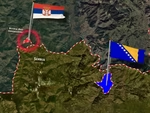Professor warns of Sarajevo's growing vulnerability to floods

Geography professor Vedran Zubic warned that the aftermath of recent floods in Bosnia and Herzegovina, particularly in Sarajevo, will be prolonged due to both natural and human-induced factors. In a discussion about the causes and potential future disasters, he highlighted deforestation, urbanization, and the city’s vulnerability to pluvial erosion as critical issues that need urgent attention.
Oglas
Professor Zubic believes that cleaning up the flooded areas will take a long time. He explained that the reasons behind this natural disaster and the resulting human tragedies can be divided into two main factors: natural and anthropogenic. “The region’s geomorphology, including that of Sarajevo, makes it highly susceptible to pluvial erosion and flash floods,” Zubic said, emphasizing the large amount of rainfall that hit the area.
Zubic pointed to the extensive deforestation, asphalt paving, and construction in areas where such development shouldn't occur. "All of this, combined with dumping waste and blocking rivers, has placed a noose around our necks," he added. He cited an example from a quarry where the accumulation of gravel and debris led to landslides after heavy rainfall, a clear case of human negligence. “This is a pure anthropogenic factor, and sadly, there’s more of this throughout the region,” he lamented.
When asked about other potential disaster zones in Bosnia, Zubic emphasized the importance of reforestation. “For instance, one beech tree can absorb 500 litres of water, and black locust trees, with their strong root systems, are excellent for stabilizing slopes,” he said. However, Sarajevo's hills, once covered in forests, are now heavily urbanized. "The forests have been cut down, replaced by asphalt and buildings," Zubic noted.
He highlighted that Sarajevo, with its 1,380 springs and streams, is particularly at risk. "Neighborhoods are named after streams like Bistricki Potok and Buca Potok, but these watercourses have been choked. Add to that the plastic waste we throw into them, and it's no surprise that flooding becomes inevitable during heavy rains," Zubic explained.
Sarajevo, with over 600 landslides, is a ticking time bomb. “In recent years, we’ve seen floods triggered by just 40 millimetres of rain. Imagine what would happen if Sarajevo received the 320 millimetres of rainfall that hit Jablanica. It would be catastrophic, especially in areas like Pofalici, Buca Potok, and Svrakino Selo, where nature has been paved over,” Zubic warned.
Kakvo je tvoje mišljenje o ovome?
Učestvuj u diskusiji ili pročitaj komentare
Oglas
Kakvo je tvoje mišljenje o ovome?
Učestvuj u diskusiji ili pročitaj komentare
Oglas
NAJČITANIJE
Oglas
Oglas
Najnovije
Oglas
Oglas





 Srbija
Srbija
 Hrvatska
Hrvatska
 Slovenija
Slovenija



























































